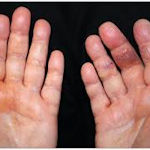
Dr. Maxwell Nartey
Professor of Symptometric Science, American School of Symptometry, NFP
Amyloidosis is a disease in which a person does not stop producing amyloids. Amyloids are the residues of starch metabolism that have not been liquefied. Enzymes are needed to liquefy starch residues. Therefore, a person who cannot produce such enzymes will produce a lot of amyloids, amylogen and amylopectin.
Then, the amyloids they produce will be deposited into their muscle fibers, thereby causing them to lose a lot of muscle mass. Loss of muscle mass will cause weight loss, and the inability to regain the weight that was lost.
There have been instances where amyloidosis caused renal failure followed by heart failure. Why? The answer is, fibroblasts could no longer deposit collagen into the person’s muscle fibers. This allowed amylogen and amylopectin to replace collagen in the organs.
Our organs are made of collagen. They are not made of amylogen and amylopectin. For this reason, a person who has amylogen and amylopectin in their tissues and organs will not be healthy. Their organs will either shrink in size or they will become enlarged like in enlarged prostate, enlarged liver, enlarged heart, enlarged spleen, etc. In medical terminology, these enlargements are called hyperplasia.
Webster’s Unabridged Dictionary of the English Language defines an amyloid as, “A non-nitrogenous food consisting of starch”. This definition leads to the identification of starch as the underlying cause of amyloidosis.
Why is starch the problem? Starch, which is scientifically known as amylum, is the problem because it is a polysaccharide, meaning, a network of sugars. A person who suffers from this disease cannot thoroughly digest starch and liquefy the starch residues. Here is why.
Starch will remain a network of sugars unless 1) the enzyme called amylase has digested it 2) ancillary conversion enzymes have converted it to monosaccharides (single sugars) and 3) another set of enzymes have liquefied the starch residues. In biochemistry, the conversion of starch (amylum) to monosaccharides is called amylolysis.
After a certain age, say age 28, 34, 42, 55, etc., many individuals stop producing high-quality amylase and the ancillary enzymes for amylolysis and for liquefaction. If amylolysis stops taking place, the person will start to produce amylogen and amylopectin instead of collagen.
Then, amylogen, amylopectin and gluten will combine with water to produce an insoluble gluey paste and tough entanglements. It is these gluey entanglements that will produce mucus in the throat that is difficult to detach, chronic bronchitis, rattling mucus in the chest, stool full of mucus, cystic fibrosis, and emphysema where the diaphragm cannot stretch, etc. In other individuals, amyloidosis has caused bleeding problems.
For example, each time the person eats potatoes, their kidneys would bleed or they would have a nosebleed. Others have had chronic diarrhea or constipation after eating a starchy food. The rest had vertigo or stubborn hypertension after eating a starchy food.
Medical technology uses iodine to confirm whether the person has amyloidosis, or not. If their tissue turns red, it confirms they have amyloidosis. If it turns blue, they have amylose, a cousin of amyloidosis.
Raw food eaters, and naturalists consider plants to be a gift from God. For this reason, plants should be eaten chaotically in the tradition of their ancestors. Symptometric science does not condone such a lifestyle. Instead, it advises such individuals to know more about plants by studying Symptometry.
Plants produce fiber (cellulose), starch and sugar with the cells called amyloplasts. The plants which have a lot of amyloplasts, and for this reason, they produce too much starch include: rice, corn, cassava, wheat, rye, millet, sorghum, soy, potatoes, oats, barley, yam and couscous.
Every plant and nut is made of cellulose, and cellulose is a polysaccharide, meaning starch. This is because the crop has cells called amyloplasts aka leucoplasts.
Therefore, all the crops and the nuts that have fiber do also have starch. However, the difference is, some vegetables have more starch than others. In addition to starch, they have lectins, allantoins, etc. and it is lectins, allantoins, etc. that block amylolysis (conversion of starch to single sugars).
Without amylolysis, the disease in the part of the body that does not have fresh DNA will be chronic. Here is why.
The backbone of DNA is a five-carbon monosaccharide called pentose aka ribose. It is the process of amylolysis that makes it possible to convert starch to monosaccharides so that ribose can be part of DNA in each of the 75 trillion cells that make up the human body.
Fresh DNA must replace old DNA during cell division. If nucleotides cannot be joined to produce fresh DNA because amylolysis cannot take place, the person will suffer from the consequences of amyloidosis. In my situation, I bled from one of my nostrils, or from both nostrils after eating yam, potatoes, rice, etc. Now that the underlying cause of amyloidosis has been discussed, what is the cure?
Curing amyloidosis
To cure amyloidosis, the three-way communication involving the genes, DNA and the three RNAs must be restored in all the cells; and amylolysis must take place. How? It is done by producing enzyme templates and enzymes.
Unfortunately, the quality of amylase many individuals produce is inferior. Then, they cannot produce enzymes for amylolysis. Producing high-quality amylase is not done with food, with herbs or with pharmaceutical drugs. It is done with one electrolyte and thermal energy from specific sources.
The electrolyte I chose was calcium, and I obtained thermal energy from sulfur and carbon. Electricity from thermal energy accelerated amylolysis. It was amylolysis that made thousands of ribose available so that fresh DNA could be produced to replace the old DNA in my nose. This was how I cured amyloidosis that was causing my chronic nosebleed. Why couldn’t physicians cure my nosebleed?
In the emergency room, they placed ice on my nose, and it stopped the nosebleed. Then, they sent me home with the instruction to just place ice on my nose anytime the nosebleed recurred, “And you will be fine. Just avoid eating starch”.
Avoiding starchy foods was totally out of the question because every plant-based food has starch in it. Instead of following their recommendation I decided to use my knowledge of physics and chemistry to analyze cold applications. Here is the observation I made that unearthed the contradictions in medical science.
A person is a hot biological existence with an average body temperature ranging from 96 degrees Fahrenheit to 98.6 degrees Fahrenheit. A cold product will lower the tissue temperature in certain parts of the body, which is a hot biological existence. Then, it would turn certain high-pressure areas into low-pressure areas. All human diseases occur in a person’s low-pressure areas because there is stasis (stagnation) in every low-pressure area.
The cold application therapy physicians recommended to me was not effective because it never changed my nose from a low-pressure area to a high-pressure area. Instead, it kept it locked in a low-pressure area causing capillary fragility.
Also, I never provided my capillaries and arteries with rutin, citral and hesperidin. This was why amylogen and amylopectin replaced collagen in my nasal tissue to cause capillary fragility.
Then, it was capillary fragility that kept causing frequent nosebleed. I am using good science to explain the underlying cause of amyloidosis; and I am delighted to be alive to tell my story.
In quantum physics, emptiness does not exist. It was because the vascular cells of my nasal capillaries could not have rutin, citral and hesperidin to strengthen them that amylogen and amylopectin moved in to take their place. This was how amylogen and amylopectin had been causing frequent nosebleed since I was 6 years old.
What is in rutin, citral and hesperidin? Deconstructive research confirms that there are different sulfur allotropes in these three nutrients. Sulfur and carbon supply thermal energy. It is the electricity from the thermal energy that accelerates cell division, and DNA repair. Then, it is after DNA has been repaired that the genes would resume sending the blueprint to it so that it is transmitted to the three RNAs.
Finally, it is ribosomal RNA that will produce the essentials to strengthen the capillaries. It is the strengthening of the capillaries that will end capillary fragility, and cure frequent nosebleed.
I cured amyloidosis that was causing frequent nosebleed because I was able to restore the three-way communication involving the genes, DNA and the three RNAs. I am glad I pulled all the stops to invent root-cause therapeutics and symptometric science. As a result of this monumental effort, the world is now benefitting from both.
Amyloidosis is perfectly curable. It is medical science that keeps getting all the facts about its underlying cause wrong. Why use something cold (ice) in a person who is hot? It is such incompatibilities that make it impossible for medical science to cure diseases.
Also, no where in medical literature is an article on amyloidosis that is as profound and as detailed as this one. I was able to write this article thanks to CURING IS PROVING, the highest principle ever, in therapeutics. We must know amyloidosis for what it really is, not for what it is not; and always focus on the source of the disease.
© Copyright 2021, The American School of Symptometry, NFP. No part of this publication may be reproduced or transmitted in any form or by any means, electronic or mechanical, including photocopying, recording, or by any information storage and retrieval system without the written permission of The American School of Symptometry, NFP. Library of Congress copyright number Txu 1-621-370, Washington D.C.


 Previous Post
Previous Post Next Post
Next Post